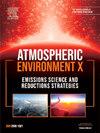Bayesian modeling of traffic-related air pollutants: A case study of urban transportation and air quality dynamics in Columbia, South Carolina
IF 3.4
Q2 ENVIRONMENTAL SCIENCES
引用次数: 0
Abstract
Traffic emissions significantly impact near-road air quality and public health. This research applies a Bayesian modeling framework to investigate these impacts using high-resolution traffic and air pollutant data from an urban corridor in Columbia, South Carolina. Despite a data collection period truncated by the COVID-19 lockdown, the Bayesian approach successfully identified significant predictors and quantified model uncertainty. Employing Bayesian Model Selection and Averaging enhanced prediction accuracy and evaluated model uncertainty. Findings indicate that higher temperatures and increased moisture levels elevate particulate matter (PM1.0, PM2.5, PM10) concentrations, while traffic speed significantly affects nitrogen dioxide (NO2) levels. Specifically, higher average traffic speeds (indicative of smoother flow) correspond to lower NO2 concentrations, suggesting that less congested conditions reduce NO2 emissions. This study highlights the robustness of Bayesian methods for generating reliable air quality insights even under data-constrained conditions. The findings underscore the importance of traffic flow management (e.g., reducing congestion) for mitigating near-road NO2 exposure and provide a basis for developing targeted public health strategies.
交通相关空气污染物的贝叶斯模型:南卡罗来纳哥伦比亚市城市交通和空气质量动态的案例研究
交通排放严重影响道路附近的空气质量和公众健康。本研究采用贝叶斯建模框架,利用来自南卡罗来纳州哥伦比亚市城市走廊的高分辨率交通和空气污染物数据来调查这些影响。尽管新冠肺炎封锁导致数据收集周期缩短,但贝叶斯方法成功地确定了重要的预测因素并量化了模型的不确定性。采用贝叶斯模型选择和平均方法提高了预测精度,并评估了模型的不确定性。研究结果表明,较高的温度和湿度会使颗粒物(PM1.0、PM2.5和PM10)浓度升高,而交通速度会显著影响二氧化氮(NO2)水平。具体来说,较高的平均交通速度(表明交通更顺畅)对应于较低的NO2浓度,这表明较少的拥堵状况会减少NO2排放。这项研究强调了贝叶斯方法的鲁棒性,即使在数据受限的条件下也能产生可靠的空气质量见解。研究结果强调了交通流量管理(如减少拥堵)对于减少道路附近二氧化氮暴露的重要性,并为制定有针对性的公共卫生战略提供了基础。
本文章由计算机程序翻译,如有差异,请以英文原文为准。
求助全文
约1分钟内获得全文
求助全文
来源期刊

Atmospheric Environment: X
Environmental Science-Environmental Science (all)
CiteScore
8.00
自引率
0.00%
发文量
47
审稿时长
12 weeks
 求助内容:
求助内容: 应助结果提醒方式:
应助结果提醒方式:


